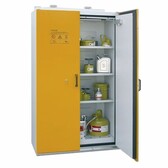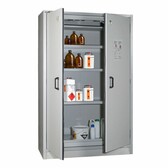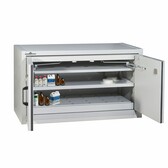Not everyone is aware that hazardous materials are handled on a daily basis. A simple child's toy battery can be hazardous under certain conditions, which is why used batteries are stored according to specific rules. Companies distributing and disposing of dangerous substances must follow the rules for storing hazardous materials. Find out what dangerous materials are and what the rules are for storing them later in this article.
Rules for storing hazardous materials
Hazardous substances have different properties. Therefore, the rules for storing hazardous materials depend on the properties of the specific agent. Acids are stored differently to fuels and solvents.
Storing hazardous substances in large quantities requires a number of conditions to be met. Every warehouse for hazardous materials must be constructed in accordance with building regulations and be resistant to the raw material that will be stored in it. Furthermore, the storage of hazardous materials must not take place too close to human settlements.
In addition to the requirements concerning the construction of the warehouse and its distance from residential buildings, there are also requirements concerning storage equipment and tools. A hazardous materials warehouse should be equipped with:
● sorbents,
● racks for corrosive substances,
● vapour extraction systems,
● surface protection systems,
● safes for chemicals,
● gas cylinder cabinets,
● sump trays.
All equipment used in a hazardous materials warehouse must be checked regularly. Any damage to racks, safes or tubs should be rectified immediately. If corrosion occurs the equipment should be replaced with a new one.
What are hazardous materials and what are their characteristics?
Hazardous materials are all substances that can endanger people, animals and the environment. This can be through contamination of soil, air, water or direct contact.
Different substances can have specific properties. The most common are flammable materials such as petrol. In addition, chlorine-based caustics and irritants are used on a daily basis in many households to clean surfaces.
Less common are chemicals with explosive, carcinogenic, toxic or mutagenic properties.
Working with dangerous substances is harmful. That is why employees in a hazardous materials warehouse use gloves, protective goggles, special overalls and gas masks to protect their bodies.
What legal provisions regulate the storage of hazardous materials?
The rules for the storage of hazardous materials are set out in:
● The Act of 27. April 2001 on Environmental Protection Law,
● The Act on Chemical Substances and Mixtures of 25th February 2011,
● Regulation of the Minister of Labour and Social Policy of 26. September 1997 on general regulations of safety and hygiene at work.
Among other things, these legal acts state that the entrepreneur is responsible for the proper storage of hazardous materials. The company's employees should be trained and know the rules of occupational safety and health. All company personnel must know what substance they are working with and how to proceed in the event of equipment failure.
Hazardous substances must be secured so that they cannot escape into the environment. In addition, the business owner must ensure that the hazardous materials storage area is fitted with machinery and equipment to prevent chemicals from entering the water, air and ground.
Tanks and storage containers must be properly marked in a visible place. In addition, the warehouse should contain instructions on how to store, load and unload hazardous materials.
Read more: Regulatory storage of weapons and dangerous substances
Safety cabinet for chemical reagents – a must for every production facility
Cabinets and safes for the storage of hazardous materials
Cabinets and safes for the storage of dangerous substances should meet a number of requirements. Such units must be equipped with an internal ventilation system. The use of earthing will effectively protect against possible explosions.
Fire protection is an important issue. Flammable materials are stored in cabinets made of fire-resistant materials. Safes in which dangerous substances are stored should effectively prevent unauthorised opening. The use of a certified lock may be a good solution.
Storing hazardous materials is not a simple matter. Not only do you have to meet many standards for the warehouse itself, but you also have to provide employees with personal protective equipment. In addition, the equipment used to store the substances is important. If you want to avoid legal sanctions, you should equip the warehouse with, among other things, fireproof and airtight safes for chemicals.
If you are interested in lithium-ion batteries, which are also hazardous materials, check out our category: battery cabinets.
Find out more: How to store lithium-ion batteries safely?
Ecological storage cabinets. To protect the environment and employees





